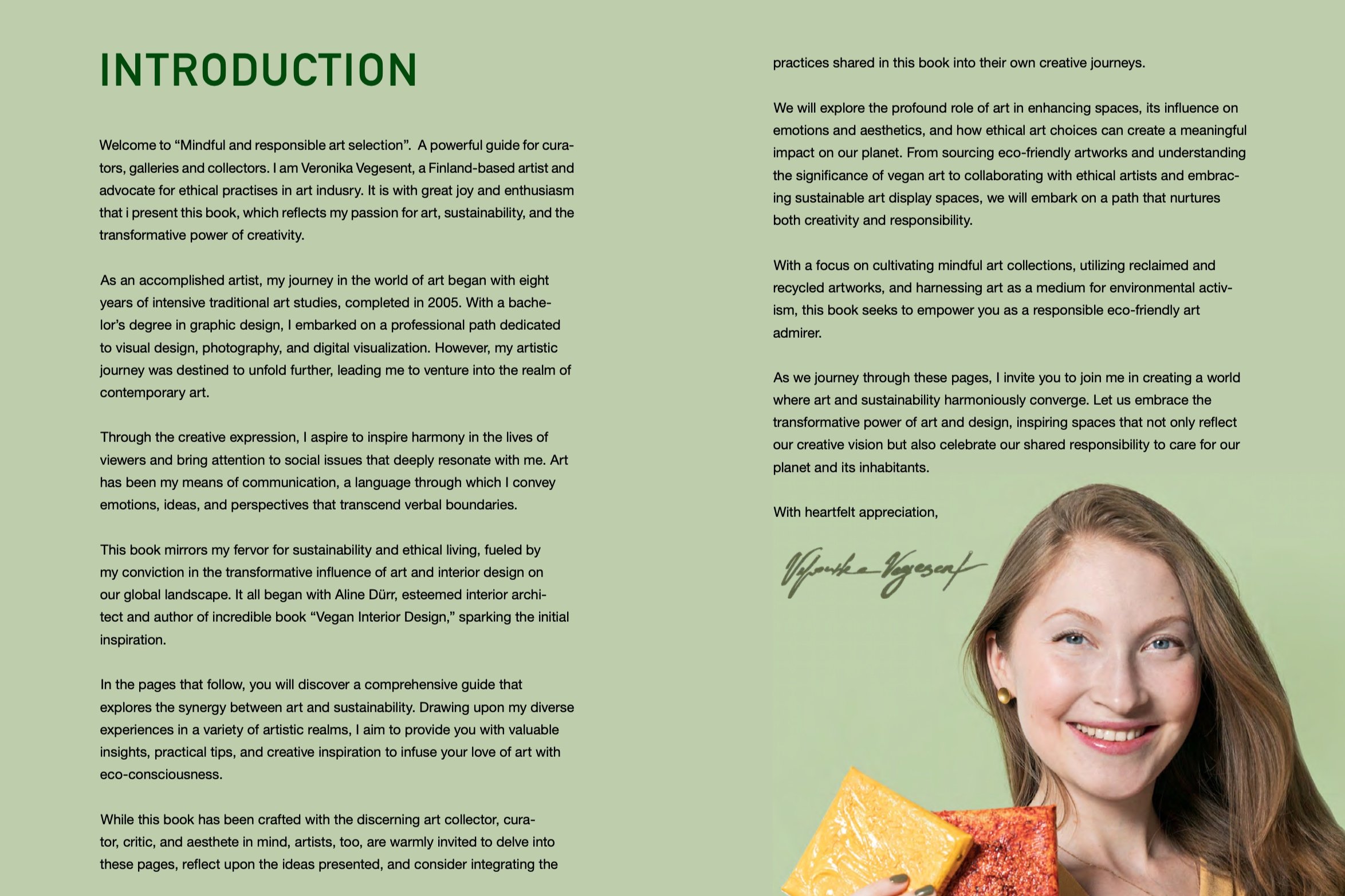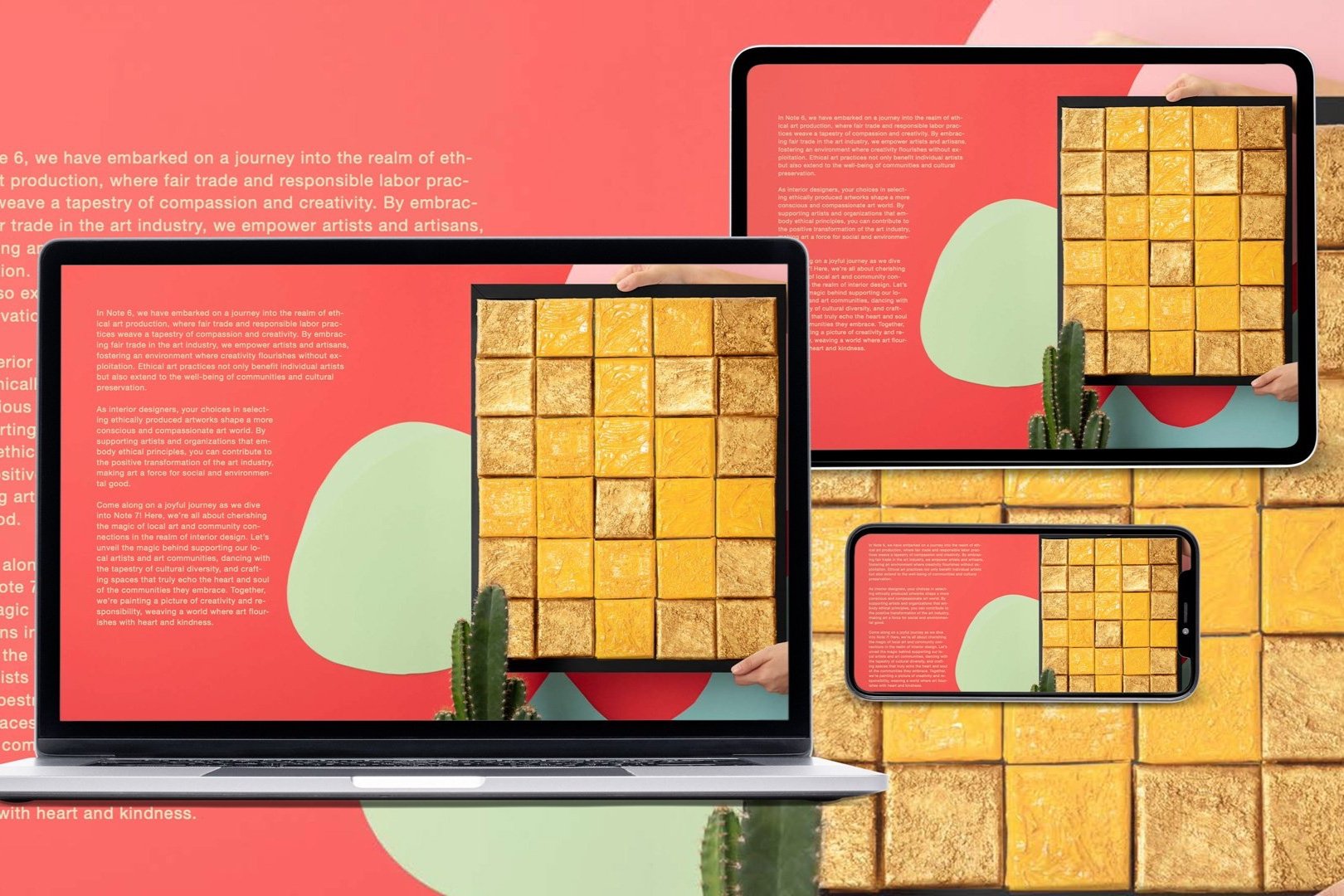Whether you're an aspiring interior designer, art curator, or conscious art collector, this guide is your key to navigating the environmental and ethical landscape of the art world. Learn to seamlessly integrate sustainable artworks and create spaces that mirror your values and aspirations.
Uncover your unique ethical style. Identify the values that inspire you, whether it's sustainability, social responsibility, or ethical sourcing. This foundational step sets the stage for creative alignment with your beliefs.
Discover artists, techniques, and materials that harmonize with your vision while making a positive impact.
Learn the art of storytelling through design. Craft narratives that connect with your vision on a profound level, evoking emotions and aligning with values. With your newfound ethical design expertise, you'll create spaces that resonate deeply and leave a lasting impact.
-
NOTE 1: INTRODUCTION The role of artworks in enhancing interior spaces How art influences emotions and aesthetics The importance of responsible art selection
NOTE 2: UNDERSTANDING PROBLEMATIC ISSUES IN ART PRODUCTION The environmental impact of art materials and production processes Ethical concerns in the art industry, such as labor practices and exploitation Art as a reflection of social and environmental responsibility
NOTE 3: ART STYLES AND THEIR IMPACT ON SPACES Exploring various art styles and their suitability for different interior design themes How to select art that complements the overall design concept Creating harmony and balance between art and interior elements
NOTE 4: SOURCING ECO-FRIENDLY ARTWORKS Identifying eco-conscious artists and art galleries Sustainable art materials and techniques The significance of upcycled and recycled art pieces
NOTE 5: VEGAN ART AND ITS SIGNIFICANCE IN INTERIOR DESIGN Understanding vegan art and its connection to animal rights Incorporating vegan art in animal-friendly interior spaces Ethical considerations when choosing animal-derived art materials
NOTE 6: ETHICAL ART PRODUCTION: FAIR TRADE AND RESPONSIBLE LABOR The importance of fair trade in the art industry Supporting artists and communities through ethical practices How to identify and choose ethically produced artworks
NOTE 7: LOCAL ART AND COMMUNITY ENGAGEMENT Emphasizing the value of supporting local artists and art communities Using regional art to celebrate cultural diversity in interior design The positive impact of community engagement on sustainable art practices
NOTE 8: MINIMALISM AND SUSTAINABILITY IN ART SELECTION The concept of minimalism in interior design and art curation Curating sustainable and eco-friendly art collections Maximizing impact with fewer art pieces
NOTE 9: RECLAIMED AND RECYCLED ARTWORKS Understanding the significance of reclaimed art in interior spaces Incorporating recycled materials and upcycled art pieces Fostering creativity through sustainable art choices
NOTE 10: ART AS A CONVERSATION STARTER FOR ETHICAL LIVING Using art to spark discussions about ecological and ethical issues Raising awareness about responsible art consumption among clients How art can inspire positive changes in lifestyle choices
NOTE 11: ART AND SUSTAINABLE ARCHITECTURE The integration of art into sustainable architectural designs Art installations that promote energy efficiency and eco-consciousness Blending art, nature, and sustainable living in interior spaces
NOTE 12: ETHICAL FRAMING AND DISPLAY TECHNIQUES Responsible framing materials and practices Sustainable display methods for art pieces Preserving art while minimizing environmental impact
NOTE 13: ART AS A MEDIUM FOR ENVIRONMENTAL ACTIVISM Exploring how art can advocate for environmental and ethical causes Collaborating with eco-conscious artists to amplify the message Harnessing the power of art to drive positive change
NOTE 14: GREEN CERTIFICATIONS FOR ART AND GALLERIES Recognizing eco-friendly certifications in the art industry Choosing art from certified green galleries Encouraging transparency and accountability in art production
NOTE 15: BUDGETING FOR SUSTAINABLE ART IN INTERIOR DESIGN Dispelling the myth of sustainable art being expensive Balancing cost and ethical considerations in art selection Budget-friendly strategies for incorporating eco-friendly art
NOTE 16: CREATING A SUSTAINABLE ART DISPLAY SPACE Designing interior spaces that accommodate ethical art curation Sustainable lighting, temperature, and humidity control for art preservation Showcasing art in an eco-friendly and visually appealing manner
NOTE 17: RESPONSIBLE ART DISPOSAL AND RECYCLING Sustainable options for art disposal and recycling Finding new life for old or damaged art pieces Supporting artists who repurpose materials in their work
NOTE 18: WORKING WITH ETHICAL ARTISTS AND ARTISANS Identifying artists and artisans committed to ethical practices Collaborating with like-minded creatives in the design process The value of promoting responsible artists and their work
NOTE 19: MEASURING THE IMPACT OF SUSTAINABLE ART IN INTERIOR DESIGN Assessing the environmental and ethical footprint of art selections Tracking the positive effects of responsible art choices How responsible art enhances the overall interior design experience Empowering designers and consumers to make ethical choices The transformative power of art in shaping responsible living Epilogue
The new updated version includes:
List of 16 eco-friendly art mediums.
A roll up of 10 art styles along with the interior styles they can complement.
Line-up of 20 environmentally harmful art techniques and their impact.
19 key questions to gather valuable information about the eco-friendliness, safety, and plant-based nature of artworks.
10 Starting points to engage in meaningful conversations about ethical living using art as a catalyst.
Index of 4 conversations with the art viewers to pave the way for a more conscious approach to life choices.
7 Framing materials with harmful chemicals that pose risks to both human health and the environment. And their sustainable alternatives!
Introduction of 7 green certifications of galleries and artists.
Collection of 5 budget-friendly strategies which can help you to find eco-friendly art.
5 eco-friendly showcasing display techniques.
6 tips of Responsible Art Disposal.
Checklist of 5 guiding principles that help to work with Ethical Artists and Artisans.
10 metrics to Measure the impact of sustainable art.





